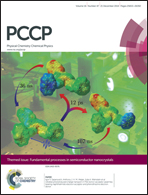Donors contribute more than acceptors to increase the two-photon activity – a case study with cyclopenta[b]naphthalene based molecules†
Abstract
In the present work, we address the question – “which among the electron donors and the electron acceptors contribute more to the two-photon (TP) activity of a donor–π–acceptor type of molecule?” For this purpose we have performed ab initio calculations to calculate the TP transition probability (δTP) of a recently synthesized (Benedetti et al., J. Am. Chem. Soc., 2012, 134(30), 12418–12421) cyclopenta[b]naphthalene based chemo-sensor and its derivatives containing different electron donor and acceptor groups. Our study revealed that both under vacuum and in solvent phases, an increase in electron donor strength (–OMe, –NH2, –NMe2) increases the δTP value up to five times, whereas, an increase in the acceptor group strength (–COCH3, –NO2, –CN) increases it by a factor of two only. The highest δTP value is obtained for the molecule having the strongest donor–acceptor pair (–CN, –NMe2) considered in this work. We have also noted that, the removal of the cyclopentane ring from the original system increases the δTP value by ∼20% and the replacement of the naphthyl group by the benzene ring decreases it by ∼70%. All these results are explained by inspecting different TP tensor elements and different transition moment vectors involved in a two-state model approach. A close scrutiny of different parameters in 2SM clearly reveals that upon increasing the strength of either the donor or the acceptor group the parameters change in favour of increasing the overall δTP values but in the case of donors this effect is much larger.
![Graphical abstract: Donors contribute more than acceptors to increase the two-photon activity – a case study with cyclopenta[b]naphthalene based molecules](/en/Image/Get?imageInfo.ImageType=GA&imageInfo.ImageIdentifier.ManuscriptID=C4CP04082A&imageInfo.ImageIdentifier.Year=2014)

 Please wait while we load your content...
Please wait while we load your content...